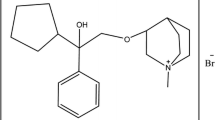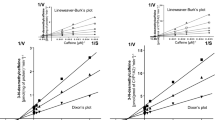Summary
The β-adrenoceptor blocker bupranolol turned out to be a competitive inhibitor of the polymorphic cytochrome P450 CYP2D6 of which sparteine is a substrate. There was stereo-selectivity of bupranolol involved: (−)-bupranolol was the weakest inhibitor with an apparent Ki value of 1.32 μM, (+)-bupranolol was the most potent with an apparent Ki value of 0.55 μM, while the therapeutically used racemic bupranolol had an intermediate value of 0.88 μM. A 10 min pre-incubation of 5 μM bupranolol with the enzyme preparation prior to the addition of substrate, reduced the inhibition of sparteine metabolism from 52 to about 25%.
This suggests that — during these inhibition studies — bupranolol was much more rapidly metabolized than was sparteine, so that the measured Ki values must represent overestimates. The enzyme catalysing bupranolol metabolism was CYP2D6: microsomes from a liver with the genetic enzyme deficiency did not metabolize bupranolol; in microsomes from livers containing the enzyme and 10 μM bupranolol, 5 μM quinidine caused a 72% inhibition of bupranolol metabolism.
Although our methods were not sufficiently sensitive to measure the Km of bupranolol directly, it is undoubtedly the β-adrenoceptor blocker with the highest-known apparent affinity for CYP2D6. High affinity and rapid metabolism are infrequent combinations in enzymology.
Similar content being viewed by others
References
Mahgoub A, Idle JR, Dring LG, Lancaster R, Smith RL (1977) Polymorphic hydroxylation of debrisoquine in man. Lancet II: 584–586
Eichelbaum M, Spannbrucker N, Steincke B, Dengler HJ (1979) Defective N-oxidation of sparteine in man: a new pharmacogenetic defect. Eur J Clin Pharmacol 16: 183–187
Meyer UA, Skoda RC, Zanger UM (1992) The genetic polymorphism of debrisoquine/sparteine metabolism — clinical aspects. In: Kalow W (ed) International Encyclopedia of Pharmacology and Therapeutics, Section 137: Pharmocogenetics of drug metabolism. Pergamon Press, New York Oxford, pp 609–623
Eichelbaum M, Gross AS (1992) The genetic polymorphism of debrisoquine/sparteine metabolism — clinical aspects. In: Kalow W (ed) International Encyclopedia of Pharmacology and Therapeutics, Section 137: Pharmocogenetics of drug metabolism. Pergamon Press, New York Oxford, pp 625–648
Alvan G, von Bahr C, Seideman P, Sjoqvist F (1982) High plasma concentrations of beta-receptor blocking drugs and deficient debrisoquine hydroxylation. Lancet II: 333
Shah RR, Oates NS, Idle JR, Smith RL (1982) Beta-blockers and drug oxidation status. Lancet I: 508–509
Otton SV, Inaba T, Kalow W (1984) Competitive inhibition of sparteine oxidation in human liver by beta-adrenoceptor antagonists and other cardiovascular drugs. Life Sci 34: 73–80
Dayer P, Merier G, Perronoud JJ, Marmy A, Leeman T (1986) Interindividual pharmacokinetic and pharmacodynamic variability of different beta-blockers. J Cardio Pharmacol 8 [Suppl 6]: 520–524
Lennard MS (1992) The genetic polymorphism of debrisoquine/sparteine metabolism — clinical aspects. In: Kalow W (ed) International Encyclopedia of Pharmacology and Therapeutics, Section 137: Pharmocogenetics of drug metabolism. Pergamon Press, New York Oxford, pp 701–720
Dayer P, Balant L, Courvoisier F, Kupfer A, Kuble A, Gorgia A, Fabre J (1982a) The genetic control of bufuralol metabolism in man. Eur J Drug Metab Pharmacokinet 7: 73–77
Dayer P, Courvoisier F, Balant L, Fabre J (1982b) Beta-blockers and drug oxidation status. Lancet I: 509
Dayer P, Balant L, Kupfer A, Courvoisier F, Fabre J (1983) Contribution of the genetic status of oxidative metabolism to variability in the plasma concentrations of beta-adrenoceptor blocking agents. Eur J Clin Pharmacol 24: 797–799
Minder EI, Meier PJ, Muller HK, Minder C, Meyer UA (1984) Bufuralol metabolism in human liver: a sensitive probe for the debrisoquine-type polymorphism of drug oxidation. Eur J Clin Invest 14: 184–189
Lennard MS, Silas JH, Freestone S, Trevethick J (1982) Defective metabolism of metoprolol in poor hydroxylators of debrisoquine. Br J Clin Pharmacol 14: 301–303
Lewis RV, Lennard MS, Jackman PR, Tucker GT, Ramsay LE, Woods HF (1985) Timolol and atenolol: relationships between oxidative phenotype, pharmacokinetics and pharmacodynamics. Br J Clin Pharmacol 19: 329–333
Lennard MS, Lewis RV, Brown LA, Tucker GT, Ramsay LE, Jackson PR, Woods HF (1989) Timolol metabolism and debrisoquine oxidation polymorphism: a polymorphic study. Br J Clin Pharmacol 27: 429–434
Kaumann AJ, Lemoine H (1978) Vergleich der Affinitäten von Bupranolol und seinen Metaboliten mit denen anderer β-Rezeptor-Hemmer. In: Rahn KH, Schrey A (eds) Betablocker, 1. Betadrenol-Symposion, Frankfurt 1977. Urban & Schwarzenberg, München Wien Baltimore, pp 4–8
Dengler HJ, Eichelbaum M (1977) Polymorphismen und Defekte des Arzneimittelstoffwechsels als Ursache toxischer Reaktionen. Arzneimittelforschung 27: 1836–1844
Tyndale RF, Gonzalez FJ, Hardwick JP, Kalow W, Inaba T (1990) Sparteine metabolism capacity in human liver: structural variants of human P450IID6 as assessed by immunochemistry. Pharmacol Toxicol 67: 14–18
Tyndale RF, Inaba T, Kalow W (1989) Evidence in humans for variant allozymes of the deficient sparteine/debrisoquine monooxygenase (P450IID1) in vitro. Drug Metab Dispos 17: 334–340
Tyndale RF, Inaba T (1990) Simultaneous determination of haloperidol and reduced haloperidol by gas chromatography usine a megabore-column with electron-capture detection: application to microsomal metabolism of reduced haloperidol. J Chromatogr 529: 182–188
Vinks A, Inaba T, Otton SV, Kalow W (1982) Sparteine metabolism in Canadian Caucasians. Clin Pharmacol Ther 31: 23–29
Dixon M, Webb EC (1964) Enzymes, 2nd edn. Longmans, London, pp 315–331
Cornish-Bowden A (1974) A simple graphical method for determining the inhibition constants of mixed, uncompetitive and non-competitive inhibitors. Biochem J 137: 143–144
Ferrari S, Leeman T, Dayer P (1991) The role of lipophilicity in the inhibition of polymorphic cytochrome P450IID6 oxidation by beta-blocking agents in vitro. Life Sci 48: 2259–2265
Otton SV, Inaba T, Kalow W (1983) Inhibition of sparteine oxidation in human liver by tricyclic antidepressants and other drugs. Life Sci 32: 795–800
Tyndale RF, Sunahara R, Inaba T, Kalow W, Gonzalez FJ, Niznik HB (1991) Neuronal cytochrome P450IID1 (debrisoquine/sparteine-type): potent inhibition of activity by (−)-cocaine and nucleotide sequence identity to human hepatic P450 gene CYP2D6. Molec Pharmacol 40: 63–68
Author information
Authors and Affiliations
Rights and permissions
About this article
Cite this article
Pressacco, J., Muller, R. & Kalow, W. Interactions of bupranolol with the polymorphic debrisoquine/sparteine monooxygenase (CYP2D6). Eur J Clin Pharmacol 45, 261–264 (1993). https://doi.org/10.1007/BF00315393
Received:
Accepted:
Issue Date:
DOI: https://doi.org/10.1007/BF00315393




